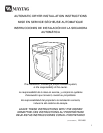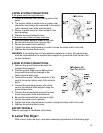
5
• Secure joints with duct tape. Do not use screws.
• DO NOT EXHAUST DRYER INTO ANY WALL, CEILING, CRAWL SPACE OR A
CONCEALED SPACE OF A BUILDING, GAS VENT, ANY OTHER COMMON DUCT OR
CHIMNEY. THIS COULD CREATE A FIRE HAZARD FROM LINT EXPELLED BY THE
DRYER.
• Plastic flexible duct can kink, sag, be punctured, reduce airflow, extend drying times and affect
dryer operation.
• Exhaust systems longer than recommended can extend drying times, affect machine
operation and may collect lint.
• The exhaust duct should end with an exhaust hood with a swing out damper to
prevent back drafts and entry of wildlife. Never use an exhaust hood with a magnetic
damper.
• The hood should have at least 12 inches (30.5 cm) of clearance between the bottom
of the hood and the ground or other obstruction. The hood opening should point down.
Never install a screen over the exhaust outlet.
• When possible, do not exhaust the dryer directly into a window well in order to avoid
lint build-up. Do not exhaust under a house or porch.
• If exhaust ductwork must run through an unheated area, the duct should be insulated
and slope slightly down towards the exhaust hood to reduce condensation and lint
build-up.
• Inspect and clean the interior or the exhaust system at least once a year. Disconnect
electrical service prior to cleaning.
• Frequently check to be sure the exhaust hood damper opens and closes freely.
If new dryer is installed into an existing exhaust system you must be sure:
• The exhaust system meets all local, state and national codes.
• That plastic flexible duct is not used.
• Inspect and clean all lint accumulation from the interior of the existing duct.
• The duct is not kinked or crushed.
• The exhaust hood damper opens and closes freely.














